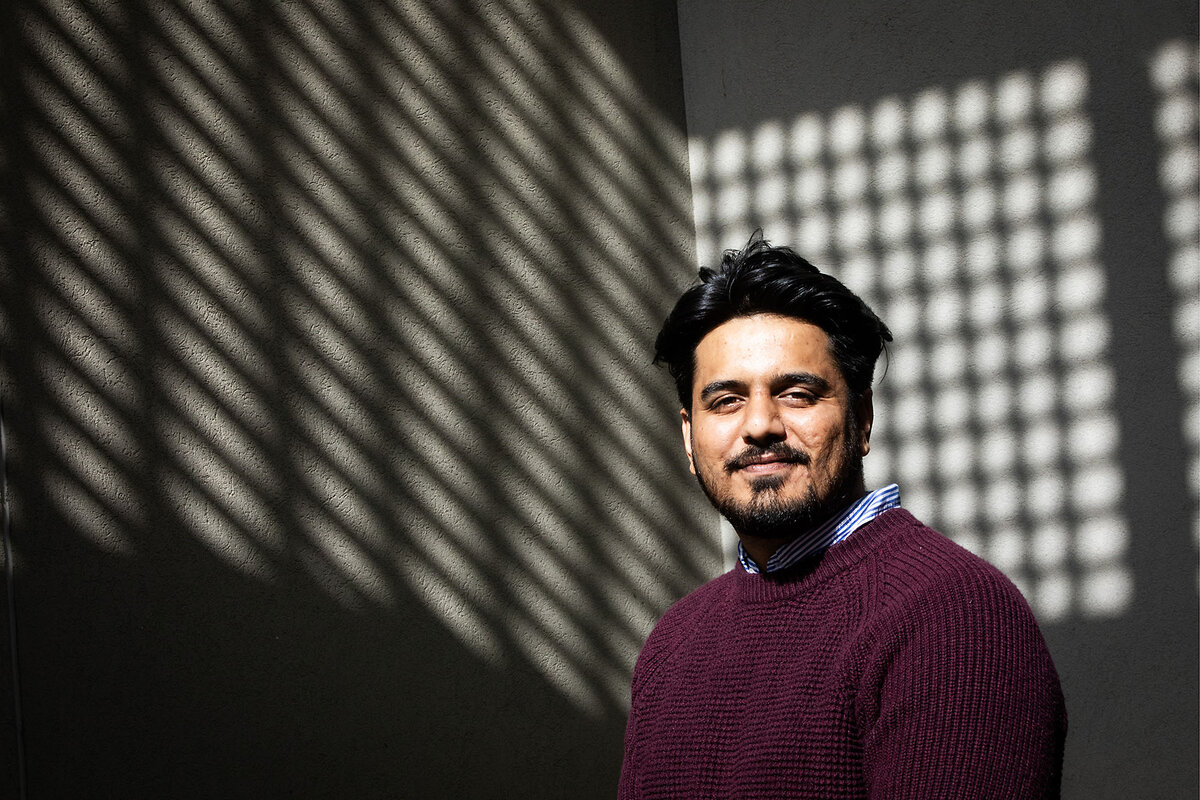With a fusion of tradition and hip-hop, a ‘Punjabi wave’ sweeps Canada
Loading...
| Vancouver, British Columbia
“Get ready to experience the biggest Punjabi artist on the planet of all time,” the voice booms across the darkened stadium.
The sold-out crowd, over 50,000 in all, roars as the lights go up and Diljit Dosanjh takes the Vancouver stage. He’s dressed in all black – from his turban, to tunic, to tinted sunglasses – except for a pair of red Nike high-tops.
And if the audacious welcome message – calling the audience the “special chosen ones” about to “witness history” – seems over the top, Mr. Dosanjh does indeed make history. The first leg of his North American tour that runs across Canada and the U.S. into the summer is touted as the largest Punjabi show ever played outside India.
Why We Wrote This
A story focused onMusic can make a community feel heard – not just literally, but figuratively, too. The rise of a “Punjabi wave” in international music is helping the Indian diaspora in Canada feel recognized in a new way.
It’s a dazzling expression of the “Punjabi wave” surging across the international music scene. Its creators, mostly Sikhs from northwestern India, mix traditional music with the hip-hop, rap, and pop beats of North America. And Canada-based musicians are leading the way. It’s a nod to the remarkable Punjabi immigration story – with all its complexities – across this country.
“This is the Punjabi wave. Nobody ever thought somebody would come and sell out BC [Place] Stadium,” says Robyn Sandhu, who came to Canada from India as an international student in 2017 and is now a hip-hop singer penning Punjabi lyrics from Surrey, British Columbia. “They’d say, ‘What are you talking about?’ It’s just crazy.”
The Canadian dream
Punjabi hip-hop, rap, and pop is definitely having a moment. In April, Canada-based Punjabi rapper AP Dhillon performed at the Coachella music festival, after Mr. Dosanjh became the first Punjabi artist to take the California stage last year. In March, Punjabi rapper Karan Aujla, based in British Columbia, took home the 2024 Fan Choice Award at Canada’s annual JUNO Awards. According to Spotify, consumption of music from India has shot up worldwide by 2,000% in the past five years.
Kavita Saini, who was born to Indian parents in small-town British Columbia, says Punjabi music was once something she heard only at weddings or inside her home, not on mainstream airwaves.
“When I was growing up, I was a minority. Now the music has blown up and it’s like, we’re getting known,” says Ms. Saini, at the Dosanjh show with her 9-year-old son at his first concert; an aunt celebrating her 76th birthday; and her mother, who keeps warning her to be wary of two journalists who approach her in case it’s a scam. “Our culture and music is getting known, and our actors and actresses. There is so much talent, so I’m just proud of us.”
The swelling Indian population in Canada buoys the genre. Canada has the largest percentage of Sikhs outside Punjab. The Indian migrant population here has grown by over a third between 2016 and 2021. Of the nearly one million international students who arrived in Canada last year, 40% hailed from India.
Many Punjabi singers – and their producers, managers, and lyricists – came as international students themselves and generated this newest wave, though Sara Grewal, a professor at MacEwan University in Alberta who is co-writing a book on Canadian Sikh hip-hop artists, says the fusion is not new. It’s simply more mainstream now that white audiences are more willing to listen to music in foreign languages.
The international student migration story is central to many Sikh singers. “For some artists, it shows up in their lyrics as the ‘Canadian dream,’ the international student with one suitcase … who is now a big star,” she says. Others rap about the discrimination international students face both by Canadians and the Punjabi community itself.
On the contrary, fraught politics between India and Canada over the assassination of a Sikh separatist leader on Canadian soil last year have hardly registered in the music.
Homeland connections
The Punjabi diaspora is centered in Brampton and Surrey, in greater Toronto and Vancouver respectively. The most recent wave of fusion music is often traced to the late Sidhu Moose Wala, an artist who had moved to Brampton as an international student and was gunned down while in India where he’d launched into politics. But the music’s hub has shifted westward in recent years.
The Punjabi community of Surrey, where nearly 30% of residents identify as Sikh, is concentrated around 128 Street. Mr. Sandhu, who goes about his days penning poems on his iPhone, spent a recent Sunday drinking mango lassis at the town’s Little India Plaza with friends, all newly arrived international students. The night before, he’d been recording a song he dubbed “128,” an ode to a city he says he loves. But in the Punjabi wave, he sees a vehicle for keeping immigrants and second-generation Indians connected to their homeland.
“A huge part of the diaspora was born here and was sort of disconnected from their culture. But once they found Punjabi music, they found a lens onto the culture,” he says. “We listen to the same music as you do. We listen to Michael Jackson. We listen to Tupac. … We’re in North America speaking English and listening to English beats and we’re rapping Punjabi over it.”
“We are so excited,” says Ikvir Chahal, who is waiting outside for the Diljit Dosanjh concert to begin. Born in Vancouver, she is here with her younger sister and friend. The girls, all students at the University of British Columbia, show off their iPhones with wallpaper images of Mr. Dosanjh. Ms. Chahal’s father, Kuldip Singh Chahal, approaches the group with his eyes lit, talking about how his village back in India is next door to Mr. Dosanjh’s.
He doesn’t have to convince his daughters that this is worth knowing.
Ms. Chahal says she loves North American rap and hip-hop. “But I love music in my language. It has a different touch. A magic to it,” she says. “We love our Punjabi music.”










